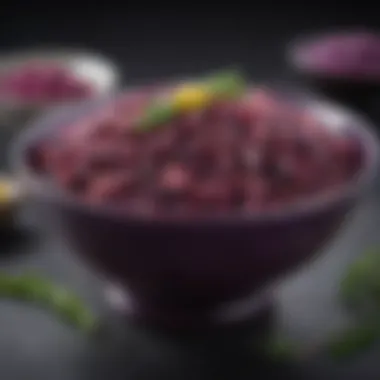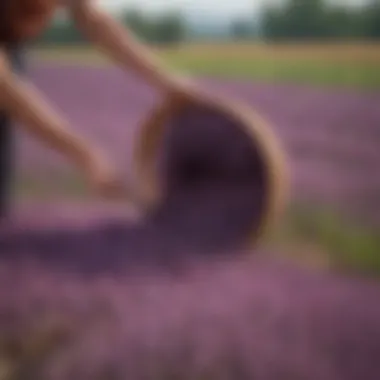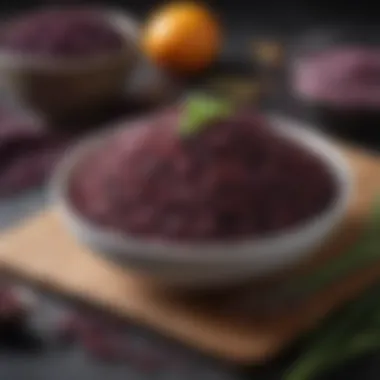Exploring Kares Purple Rice: A Culinary Jewel


Intro
Kares purple rice stands out as a unique grain, cherished for its striking color and nutritional benefits. This rice has woven itself into the fabric of various cuisines, showcasing versatility that appeals to food lovers across the globe. In this article, we will investigate the components that contribute to its growing appeal in contemporary gastronomy.
Throughout history, Kares purple rice has provided more than just sustenance; it holds cultural significance and offers a glimpse into the agricultural practices of the regions where it is cultivated. Nutritionally, this rice is a powerhouse, rich in antioxidants and essential minerals. Therefore, its growing popularity among health-conscious individuals is not surprising.
As we progress through the sections of this article, we will explore recipes that highlight the distinct qualities of Kares purple rice. Additionally, we will discuss its cultivation methods, processing techniques, and its role in enhancing numerous dishes.
In essence, this journey into the world of Kares purple rice not only informs but also aims to educate readers about how best to integrate this culinary jewel into their cooking.
Preface to Kares Purple Rice
Kares purple rice stands out in the world of grains. It is not just a food item; it is a blend of history, culture, and nutrition. Understanding Kares purple rice is crucial, as it represents a unique link between tradition and modern dietary needs. This section will highlight its definition and origin, as well as its cultural significance.
Definition and Origin
Kares purple rice is a type of heirloom rice known for its distinct purple hue. This color comes from the presence of anthocyanins, a type of antioxidant. Grown primarily in Southeast Asia, Kares purple rice has been cultivated for centuries. Its origins can be traced back to specific regions in Vietnam, where local farmers have cherished it for its flavor and health benefits.
The grain is slightly sticky when cooked, making it ideal for various culinary applications. As more consumers seek healthful alternatives to conventional white rice, Kares purple rice has gained attention. Its unique attributes make it a valuable addition to dishes, attracting food enthusiasts and health-conscious individuals alike.
Cultural Significance
Kares purple rice holds a deep cultural significance within many Southeast Asian communities. It is more than a staple food; it is part of rituals, celebrations, and daily life. In many regions, this rice is associated with prosperity and is served during important occasions.
Traditionally, farmers have cultivated Kares purple rice using heirloom methods passed down through generations. This practice not only preserves biodiversity but also ensures the rice retains its unique qualities. As the world becomes more influenced by global cuisine, Kares purple rice continues to be an emblem of cultural heritage, reminding us of the connection between food and identity.
The rise in interest for Kares purple rice showcases a balance between preservation of tradition and modern gastronomy. Its rich nutrient profile enhances its value in today's health-oriented society.
Nutritional Profile
Kares purple rice is not just visually striking but also packed with nutrition. Understanding the nutritional profile of this grain reveals much about its potential health benefits and culinary versatility, making it a worthy addition to a diverse diet. Among its many attributes, the presence of essential vitamins and minerals stands out, contributing to its status as a superfood.
Vitamins and Minerals
Kares purple rice is rich in several vitamins and minerals that play crucial roles in maintaining optimal health. Notably, this rice variety contains significant amounts of B vitamins, including thiamine and niacin, which support energy metabolism and promote healthy skin and nerves. Additionally, it is a source of magnesium, which is vital for numerous physiological functions such as muscle contraction and nerve transmission.
Other important minerals include iron, which aids in oxygen transport within the body, and zinc, crucial for immune function and wound healing. This diverse mineral content enriches the diet, providing essential nutrients that many people may lack in processed food.
Antioxidant Properties
The vibrant hue of Kares purple rice signals its rich antioxidant properties. It contains anthocyanins, which are powerful antioxidants responsible for its deep color. Antioxidants help neutralize free radicals in the body, reducing oxidative stress. This has significant implications for health, as oxidative stress is linked to various chronic diseases, including heart disease and cancer.
Research suggests that the antioxidants found in Kares purple rice may contribute to improved overall health and longevity. The consumption of foods high in antioxidants can also enhance brain health and improve cognitive function, making this rice variety a valuable element in a balanced diet.
Health Benefits
The health benefits of Kares purple rice extend beyond its nutrient profile. Regular consumption may offer several advantages:
- Weight Management: The high fiber content helps in promoting satiety, which may assist in weight management.
- Diabetes Control: The low glycemic index makes Kares purple rice a suitable option for individuals managing their blood sugar levels.
- Heart Health: Its antioxidant properties contribute to cardiovascular health by lowering blood cholesterol levels and improving arterial function.
Incorporating Kares purple rice into your meals not only provides essential nutrients but also enhances flavor and texture. Its versatility allows it to be paired with various ingredients, enhancing both culinary experience and health.
Culinary Applications
Culinary applications of Kares purple rice showcase its versatility in the kitchen. As this rice variety gains popularity, understanding its uses in different dishes becomes essential for food lovers and chefs alike. The unique flavor and appearance of Kares purple rice enhance various culinary creations. Its cultural roots inspire traditional dishes, while modern adaptations show how it can fit into contemporary cuisine.


Traditional Dishes
Traditional dishes featuring Kares purple rice are often rich in flavor and cultural significance. In many Asian countries, this rice is used in festive meals and ceremonies. For example, in certain regions, it is steamed and served with coconut milk, creating a fragrant and sticky treat.
Common dishes include:
- Rice Pudding: This dish combines Kares purple rice with sweetened coconut milk, often garnished with toasted coconut.
- Pilaf: Some cultures prepare a savory pilaf, incorporating aromatic spices and vegetables, showcasing the rice's distinct color and flavor.
- Sticky Rice: Served in small bites at celebrations, it tends to be sweet and is often paired with fruits or desserts.
These preparations highlight not only the taste but also the visual appeal of Kares purple rice.
Modern Recipes
In modern gastronomy, Kares purple rice attracts chefs looking for unique ingredients to elevate their dishes. Its visual appeal and nutritional benefits provide many opportunities for innovation.
Examples of contemporary recipes include:
- Salads: Cold salads with Kares purple rice, tossed with fresh vegetables and a light vinaigrette, are a colorful and nutritious option.
- Bowl Dishes: Combining Kares purple rice with proteins like grilled chicken or tofu, and adding assorted vegetables achieves a well-balanced meal.
- Desserts: Chefs experiment with desserts such as rice cakes or panna cotta, incorporating Kares purple rice for an exotic twist.
These modern dishes invite creativity and highlight the adaptability of Kares purple rice in various culinary contexts.
Pairing with Other Ingredients
Pairing Kares purple rice with other ingredients enhances its flavor and texture. Understanding complementary flavors is essential for creating harmonious dishes.
- Herbs and Spices: Ingredients like cilantro, lime, and ginger pair well, adding freshness and zing. These enhance the rice's inherent flavor.
- Proteins: Grilled meats, seafood, and plant-based proteins complement the rice nicely. The richness of these proteins balances the subtle flavor of Kares purple rice.
- Vegetables: Roasted or sautéed vegetables such as bell peppers, carrots, and peas contribute additional color and nutrients.
When creating dishes with Kares purple rice, consider textures and flavors to achieve a well-rounded plate.
"Kares purple rice not only adds an aesthetic dimension to meals but also signifies health and tradition in its use across varying culinary landscapes."
In summary, the culinary applications of Kares purple rice illustrate its significance across traditional and modern recipes. Its ability to pair with various ingredients further solidifies its place in the food industry, appealing to diverse tastes and preferences.
Cultivation of Kares Purple Rice
Cultivating Kares purple rice holds significant importance in understanding this unique grain. The cultivation process not only affects the quality of rice but also influences its nutritional content and flavor profile. By examining the elements of its growth, we can appreciate how they contribute to the rice's overall appeal in culinary contexts.
Growing Conditions
The successful growth of Kares purple rice depends on various conditions. Soil quality plays a crucial role; nutrient-rich, well-drained soil is essential for healthy plants. Traditionally, rice is cultivated in flooded fields. This method provides moisture, controls weeds, and protects the plants from certain pests. Kares purple rice tends to flourish in warm climates, typically between 20 to 30 degrees Celsius. Proper sunlight is vital, as this variety needs ample light to produce the vibrant color and nutritional benefits it's known for.
Key Factors for Optimal Growth:
- Water Management: Flooded rice fields help retain moisture.
- Soil Selection: Nutrient-rich soils support strong plant growth.
- Temperature Regulation: Warm temperatures enhance cultivation success.
Harvesting Techniques
Harvesting Kares purple rice requires careful techniques to retain its texture and flavor. Typically, the rice is ready for harvest when the grains are firm and the color shifts to a deeper shade. It's best to harvest during dry weather to minimize moisture content. Farmers often use conventional tools like sickles for smaller fields, while larger areas may employ machinery. Manual harvesting allows for selected picking, ensuring only the best grains are collected, which is beneficial for quality control.
Sustainable Practices
Sustainability is an increasing concern in rice cultivation, including Kares purple rice. Farmers are adopting several sustainable practices to minimize environmental impact. One practice is crop rotation, which helps maintain soil health and reduces pest infestations. Moreover, integrated pest management strategies are crucial in preventing chemical runoff. Eco-friendly fertilizers, like compost, enrich the soil while keeping it chemical-free. These practices not only contribute to better yields but also align agriculture with environmental preservation.
In summary, understanding the cultivation of Kares purple rice illuminates its journey from field to plate. The focus on growing conditions, harvesting techniques, and sustainable practices is necessary for appreciating its role in gastronomy. This holistic approach gives consumers insight into their food choices and encourages a deeper connection with what they eat.
Processing and Preparation


The processing and preparation of Kares purple rice are essential aspects to comprehend as they directly impact its flavor, texture, and overall nutritional value. This section delves into the techniques used during these stages and their significance in enhancing the consumption experience. The right handling of this unique rice not only preserves its inherent qualities but also maximizes its benefits, thus making it more appealing to both culinary professionals and home cooks.
Milling Techniques
Milling is a crucial step in transforming raw Kares purple rice into a consumable form. The process entails removing the tough outer husk while retaining the nutrient-rich bran layer. This milling process is critical as it significantly affects the rice's taste and nutritional profile. There are several milling methods employed, each varying in efficiency and impact on the final product.
- Traditional Stone Milling: This method involves grinding the rice between two stones. While it is time-consuming, it helps preserve more nutrients and offers a distinctive taste.
- Modern Mechanical Milling: This approach uses machines that can process large quantities swiftly. However, it may remove some nutrients due to higher friction.
- Semi-Polishing: This technique involves only a light polishing of the rice. It retains essential vitamins and minerals while providing a better texture for cooking.
Each milling technique has its strengths and weaknesses, influencing how Kares purple rice will cook and taste. As consumers become more health-conscious, the trend is shifting towards methods that preserve more nutrients, emphasizing the importance of dialogue between producers and consumers.
Cooking Methods
The cooking methods applied to Kares purple rice elevate its culinary potential, allowing for a versatile ingredient that can fit various recipes. The right technique can bring out the unique flavor profile and retain its beautiful color. Here are some popular cooking methods:
- Boiling: This is the most straightforward method. Rinsing the rice, then combining it with water in a pot allows the grains to absorb moisture and become tender. Adjusting the water ratio is crucial to achieving the desired consistency.
- Steaming: Steaming Kares purple rice adds moisture without immersing it in water, which can make it fluffier. The process enhances the rice's natural flavor while keeping nutrients intact.
- Pilaf: This method involves sautéing the rice briefly before adding liquid. This process can infuse the dish with additional flavors from spices and aromatics, offering a richer taste.
- Pressure Cooking: Utilizing a pressure cooker can significantly reduce cooking time. However, careful monitoring is necessary to avoid overcooking, which can lead to a mushy texture.
"Each cooking method unlocks different characteristics of Kares purple rice, allowing chefs to craft diverse dishes that highlight its culinary value."
To summarize, processing and preparation are vital stages that shape the consumption experience of Kares purple rice. Understanding milling techniques and mastering various cooking methods can enhance its appeal in modern gastronomy. As culinary enthusiasts explore this ingredient, recognizing these elements can facilitate innovative approaches to incorporating Kares purple rice into diverse dishes.
Market Demand and Availability
The increasing interest in Kares purple rice is reflecting significant changes in consumer preferences and culinary trends. As food lovers become more health-conscious, the demand for nutrient-rich ingredients has surged. Kares purple rice stands out due to its unique nutritional profile and aesthetic appeal. It is more than a food item; it represents a shift towards wholesome eating practices. This section delves into current trends shaping the market, and explores regional variations influencing availability.
Current Trends
Recent studies show a rising trend in the health and wellness food markets. Many consumers seek ingredients that are not only nourishing but also visually appealing. Kares purple rice fits this criterion perfectly. Its striking color is often associated with health and vitality. Furthermore, the popularity of plant-based diets is contributing to its demand. Many chefs are incorporating Kares purple rice into their menus, emphasizing its versatility in different culinary applications.
Moreover, Kares purple rice's popularity is supported by social media. Platforms such as Instagram and Pinterest are flooded with images of vibrant dishes featuring purple rice. This visual marketing plays a key role in attracting a younger audience who are eager to explore unique culinary experiences. As a result, restaurants and retailers are more inclined to feature Kares purple rice in their offerings.
Regional Variations
The availability of Kares purple rice can vary greatly across different regions. In countries like Thailand and Vietnam, it is widely celebrated and readily available in local markets. Farmers in these regions have cultivated the rice for generations, ensuring a steady supply. However, in regions where Kares purple rice is less well-known, sourcing may prove challenging.
In Western markets, the rice is often introduced through specialty stores and health food outlets. These markets are experiencing a gradual increase in import and sales of Kares purple rice. However, the supply may not always meet the rising demand. This leads to price fluctuations and limited availability in certain areas.
"Kares purple rice not only enriches plates but also embodies a fusion of tradition and modernity."
In summary, as health trends continue to evolve, Kares purple rice holds a promising position in the culinary world. Its market demand is tied closely to cultural influences and regional availability. Understanding these aspects is crucial for both consumers and producers as they navigate this dynamic food landscape.
Kares Purple Rice in Global Cuisines
Kares purple rice holds a unique place in various culinary traditions worldwide, providing aesthetics and distinct flavors. As kitchens globally adapt to this ingredient, its versatility garners attention. From enhancing traditional Asian recipes to inspiring innovative Western dishes, this rice proves beneficial for both health and gastronomy. The discussion of Kares purple rice in global cuisines reveals its significance and growing popularity across different cultures.
Asian Cuisine
In Asian cuisine, Kares purple rice is cherished for its cultural roots and health benefits. It is often used as a staple in many traditional dishes. The rice's nutty flavor and chewy texture make it an appealing choice in recipes. For instance, it is common in desserts like black rice pudding or is served alongside rich curries.
Notably, countries like Thailand and Indonesia incorporate this rice into their culinary practices, using it in both savory and sweet dishes. This rice’s beautiful hue adds visual appeal on the plate, making it a popular choice for chefs aiming to create vibrant meals.
Furthermore, it is often prepared using steaming or boiling methods, which maintain its nutritious profile. The rice's antioxidants and nutrients align well with the emphasis on fresh, wholesome ingredients in Asian gastronomy.
Western Adaptations
Kares purple rice is not confined to Asian cuisine; Western chefs also explore its potential. Its distinctive color enhances the aesthetic of various meals, making it an attractive component in gourmet dining. In salads, it provides texture and nutrition, often paired with ingredients like arugula, roasted vegetables, or fruits like mango.


In addition, the trend of plant-based eating has brought Kares purple rice to the forefront, as its health benefits align with modern dietary preferences. Chefs experiment by using it in risottos or as a base for grain bowls, blending international flavors with this unique grain.
Moreover, incorporating Kares purple rice into gluten-free products is proving effective. As demand for gluten-free options rises, this rice can replace traditional grains in a variety of baked goods, expanding its presence in the Western market.
"As culinary trends evolve, Kares purple rice demonstrates versatility that resonates with modern tastes, appealing to chefs and home cooks alike."
Overall, Kares purple rice illustrates how an ingredient can journey beyond its cultural origins. Its integration in both Asian and Western cuisines points to a broader trend focused on health and innovation. As more kitchens embrace Kares purple rice, its culinary impact is likely to expand even further.
Challenges in Production
The journey of Kares purple rice from the field to the plate includes several challenges that impact its overall production. Understanding these challenges is crucial to appreciating the depth and intricacies of this culinary gem. The obstacles faced in its cultivation and market reach are more than just logistical issues; they reflect broader trends in agriculture and consumer behavior that affect its availability and sustainability.
Agricultural Issues
Kares purple rice requires specific growing conditions, which can be a limiting factor in its production. These conditions include appropriate soil types, climate, and water availability. For instance, the rice thrives in wetland areas, which can be challenging to maintain, especially in regions facing climate variation. Drought and abnormal rainfall can affect the growth cycle and yield of Kares purple rice, leading to inconsistencies in supply.
Labor availability is another significant agricultural issue. In many regions, farmers are transitioning away from traditional practices, opting for faster, more profitable crops. This shift puts Kares purple rice at risk, as fewer hands are available to cultivate it. Investment in training and education for farmers on the unique benefits of Kares purple rice could help alleviate this problem.
"Understanding the agricultural issues surrounding Kares purple rice helps us appreciate its unique value in the culinary world."
Market Accessibility
Market accessibility presents another layer of challenges. Despite its nutritional benefits and culinary versatility, Kares purple rice often struggles to find its place on supermarket shelves. Large-scale rice production often overshadows small niche markets like Kares. This results in limited visibility for consumers and can affect market demand.
Additionally, the pricing of Kares purple rice can act as a barrier. Since it is often produced in smaller quantities compared to common white rice, prices can be higher, making it less attractive to a budget-conscious consumer base. Efforts to promote the health benefits and unique flavor profile of Kares purple rice can help increase its appeal and market presence.
Historically, markets are also regional, which means that even if Kares purple rice is cultivated in significant quantities, access can vary greatly depending on location. Building networks between producers and distributors can help bridge this gap and enhance market accessibility worldwide.
Future of Kares Purple Rice
The future of Kares purple rice holds significant potential for culinary and agricultural innovation. As food lovers become increasingly interested in unique and healthful ingredients, this rice is well-positioned to play a vital role in modern gastronomy. Its distinct color, flavor, and nutritional benefits make it an attractive option for chefs and consumers alike. Additionally, the sustainability practices associated with its cultivation align well with contemporary food trends focused on environmental responsibility.
Innovation in Cultivation
Traditionally, Kares purple rice is cultivated using methods passed down through generations. However, the future of its cultivation is likely to incorporate advanced agricultural technologies. Precision farming techniques can improve efficiency and crop yield. For instance, using drones and sensors can help monitor plant health, soil conditions, and water needs. This minimizes resource waste, leading to more sustainable farming practices.
Furthermore, developing hybrid varieties of Kares purple rice may enhance resilience to climate change. These hybrids could potentially withstand pests and extreme weather, making them more suitable for diverse growing environments. Encouraging research in genetic engineering might also lead to crops with superior nutritional profiles, thus widening their appeal in the nutraceutical market.
Potential in Nutraceuticals
Kares purple rice possesses many health benefits. Its high antioxidant content suggests promising opportunities for use in nutraceutical applications. Antioxidants like anthocyanins give this rice its rich purple color and are known to combat oxidative stress and inflammation in the body.
The interest in functional foods is on the rise. This shift means that products rich in nutrients and other health benefits can expect a warm reception in the market. Kares purple rice could very well become a fundamental ingredient in health supplements and fortified foods.
Additionally, its potential could extend to gluten-free products. As more people adopt gluten-free diets, Kares purple rice can fulfill a crucial gap in this market by offering a versatile and nutritious option.
"With its unique health benefits and aesthetic appeal, Kares purple rice is likely to become a staple ingredient in the wellness and culinary sectors alike."
End
The conclusion of this article emphasizes the multifaceted significance of Kares purple rice. This unique grain not only serves as a culinary delight but also enriches diets with its nutritional properties. By integrating Kares purple rice into various meals, consumers can enjoy its distinct taste while benefiting from its richness in vitamins, minerals, and antioxidants. This rice is more than just a food source; it represents a cultural identity and agricultural heritage.
Summary of Key Points
- Historical Significance: Kares purple rice has deep roots in various cultures, symbolizing tradition and festivity.
- Nutritional Benefits: Rich in antioxidants and essential nutrients, it supports healthful eating practices.
- Culinary Versatility: Kares purple rice can be used in traditional dishes and modern recipes, appealing to diverse palates.
- Sustainability in Cultivation: The methods for growing and processing this rice reflect an awareness of environmental impact, making it a responsible choice for consumers.
- Global Adaptation: As it continues to gain popularity, Kares purple rice adapts to various cuisines, making it a global culinary jewel.
Final Thoughts
"Incorporating Kares purple rice into meals connects us to our heritage and promotes innovative cooking habits."
Through this exploration, we hope to inspire food lovers of all ages to explore and appreciate the essence of Kares purple rice.







